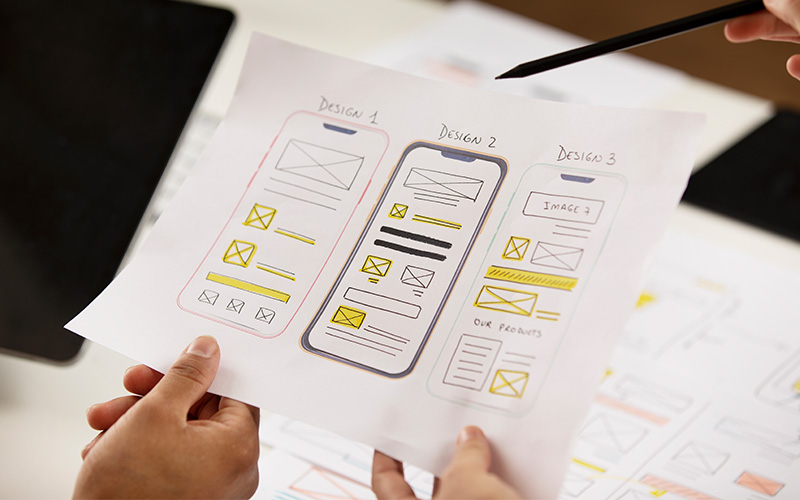A strong website opens the door to many possibilities. Building a good website and establishing a
strong online presence requires several different factors. Good websites don’t just employ successful
marketing strategies, they also put the user experience first. They draw visitors in with interactive
website design, SEO, and other important sales funnels. In this article, we will talk about some of the
components you need to use to build a successful website in 7 simple steps.
The key to great website design is differentiation. The design of your website should solve your
visitors’ problems whilst providing clear and straightforward messaging that instructs visitors on
what to do next. Gaining trust with visitors is crucial, paired with seamless website design that is
user-friendly and fits your brand.
Consider your audience and keep this in mind when developing your website design. Don’t overlook
usability and accessibility. Let the knowledge from your initial user research and information
architecture come through in the visual components. Navigation should be easy, simple, and more
importantly consistent!
Develop your website design around the target user and create a wireframe to help you understand
the layout and design. Once you do this, you will find it easier to understand the design's direction.
Additionally, you’ll be able to express your desires if you’re working closely with a web designer.
Develop Your Content Strategy
Content is king! Accompanied by strong website design and visuals, should be top-notch, pertinent,
and captivating material. Well written content will be rewarded with greater Google Search Engine
ranking, but we will discuss this in our next top tip.
Pay attention to content that is motivated by the needs of the audience and integrate analytic tools
on your website. This will help keep your content relevant and give you greater insight into the
behaviours of your customers. It will also tell you how successful your website is performing and will
help you identify areas which require more SEO improvement.
Search Engines love new content. To keep your website up to date, you should churn regular content
or update content that isn’t performing up to scratch. Your SEO will be improved the more you do
this.
So, let’s talk about conversion. If you don’t inform your visitors where to go or what you want them
to do, you could have a great website but with little to no conversion. Call to actions is another
method for directing users to the information they require. Users will be persuaded to buy from you
or use your services if you make these buttons stand out from the rest of your content. How you
place and identify your call to action will depend on your goal.
There are other elements that contribute to the success of your website such as how you
communicate your businesses’ narrative and how you display price, quality, imagery, brand, and
customer service across your pages.
Build a Mobile-Friendly Website
Device accessibility is important so that your website can be accessed on any device. The mobile
site will become increasingly significant as Google (and other search engines) shift to a mobile
first index.
Google will also measure the loading time on your site and views the speed at which a site loads
as a key ranking criterion, particularly on mobile devices. Therefore, we advise that your website
load as rapidly as possible. Using compressed images and analysing your performance analytics
will keep your pages loading at a good speed.
SEO Best Practice to Improve Organic Traffic
promote, how people will find you online, and developing a seamless strategy for your website.
The first step to SEO is making sure that you are utilising the most recent SEO best practices.
Here are some useful SEO techniques that will help you raise your website rankings through
Google.
1. Add keyword rich, user-friendly URLS: Avoid any published broken links to make your users
journey as seamless as possible.
2. Use headers and subheadings: make sure your title tags and headings are all labelled
correctly (H1, H2, H3 etc.) You want to make sure you distinguish text from titles so that
your content is accessible. These are HTML tags for the page’s header. They let Google know
what the subject of your page is, and they are essential in terms of SEO.
3. Image optimisation: You can make your images more understandable to search engines by
giving them alt-tags, which will also improve the SEO value of your pages. Search Engines
use this information to provide value to images. They are also used by screenreaders for
users who are blind or who have dexterity problems.
4. Use keywords related to your content: choose the correct keywords using a keyword
research tool will help pass Google’s test on search intent. Long tail keywords normally
attract more relevant traffic but tend to boast lower search volumes.
5. Use Meta descriptions: A page’s content can be summarised using a meta description tag. It
should be written in the most compelling way possible.
6. Use Internal linking wherever possible: When used the right way, internal linking structures
will help your website boost its rankings.
7. Earn authoritative backlinks: Backlinks are considered “votes of confidence” by Google from
other websites to yours. Your webpages are more likely to rank highly if they have a lot of
authoritative backlinks.
Use Analytics to Measure Your Website’s Success
Google Analytics can provide a wealth of data for you to analyse and some of the most widely
used Content Management Systems have their own compatible plugins. Keeping an eye on your
analytics will help you develop a smart strategy that can be used to demonstrate and forecast
your ROI. It is simpler to see where your website is succeeding and where it could use some
future improvements if your analytics tool is located right on your website.
Running Hotjar or another programme that analyses user behaviour is something else we’d
suggest. You can use its findings to get a thorough grasp of the user experience (UX) of your
website, but you can also use it sometimes to identify certain problems or points of dispute.
Keep Your Website Secure and Safe
A trusted and secure Content Management System is one of the most important factors for
website building. Trust is essential so that your visitors know that their details will be safe when
purchasing or accessing your services.
Your platform must be completely secure with dependable, secure hosting and technical
assistance. It can be tempting to cut corners and select the least expensive web hosting option
available. Other costs associated with a cheap web host include excessive downtime, sluggish
site speeds, and limited or non-existent assistance.
Finally, it’s also crucial to keep your Content Management System up to date with software
updates. Maintaining complete platform updates ensures that you are using the most cutting-
edge software available. These updates most frequently focus on maintaining the safety of your
data, your users, and your website. You will also need to start by installing an SSL certificate and
restricting the number of users who may make changes to your site.
There are so many elements that help build a successful website and we have highlighted some of
the most important components that you will need.
Websites should always promote credibility and trust. Always keep your company’s values in mind
and convey them in all your writing. Focus on writing SEO-friendly copy and don’t undervalue your
keywords. Provide the crawler bots with a tonne of mouth-watering words to chew on!
Keep your website accessible to users and employ various SEO strategies to keep your website
indexed on Google. You can track your progress through site analytics and concentrate on creating a
strategic content plan. Lastly, keep your website up to date with security scans and backing up your
site’s data. All these elements will no doubt create a successful website that truly converts!









